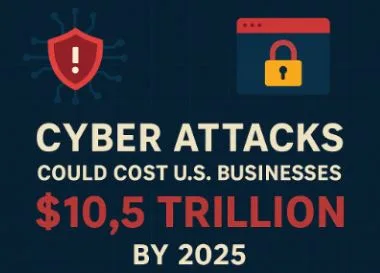Cyber Attacks Could Cost U.S. Businesses $10.5 Trillion by 2025: A Closer Look at the Rising Threats
Cybersecurity threats are no longer a distant possibility; they are a financial and operational reality for businesses across the United States. According to recent estimates, cyber attacks are projected to cost U.S. companies a staggering $10.5 trillion annually by 2025, signaling a national crisis that demands urgent action. The rise in frequency, complexity, and scale of cyber attacks has made it essential for organizations to understand the different types of cyber attacks they face and the severe economic consequences these can bring.
This article delves into the nature of modern cyber threats, how they affect American businesses, and why the financial impact is expected to grow at such an alarming rate.
The Rising Cost of Cybercrime in the U.S.
A recent analysis by NCSE reveals that cybercrime is on track to cost U.S. businesses a monumental $10.5 trillion annually by 2025. This dramatic surge is fueled by a variety of factors: increasing digital connectivity, remote work environments, and the rapidly evolving tactics used by cybercriminals.
The economic damage isn’t limited to immediate financial losses. It includes downtime, regulatory penalties, reputational harm, legal fees, and long-term customer trust issues. Small and medium-sized enterprises (SMEs), which often lack robust security frameworks, are especially vulnerable and frequently targeted.
Why Are Businesses Prime Targets?
U.S. businesses are attractive targets for several reasons:
- Valuable Data: Companies store large amounts of personal and financial data.
- Digital Transformation: Cloud adoption, remote work, and online platforms increase attack surfaces.
- Lagging Cybersecurity: Many businesses still use outdated software or lack adequate training for employees.
- High Ransom Payouts: Attackers know that companies may be willing to pay to restore operations quickly.
The consequences are severe many companies take months to fully recover from an attack, and some never do.
Major Types of Cyber Attacks Threatening U.S. Companies
Understanding the types of cyber attacks is the first step toward effective defense. Here are the most common and dangerous ones affecting U.S. businesses today:
1. Phishing Attacks
Phishing remains the most prevalent form of attack. Cybercriminals trick employees into clicking malicious links or giving away credentials through deceptive emails that appear legitimate. These attacks are responsible for over 90% of data breaches, making them a top concern.
2. Ransomware
In a ransomware attack, hackers encrypt a company’s files and demand a ransom payment for their release. U.S. businesses have lost billions of dollars in ransom payments alone. The healthcare, legal, and education sectors are especially vulnerable.
3. Denial of Service (DoS) and Distributed Denial of Service (DDoS) Attacks
These attacks flood a company’s network with excessive traffic, causing systems to crash and services to become unavailable. They can paralyze ecommerce platforms, financial institutions, and SaaS companies, leading to major financial setbacks.
4. Insider Threats
Insider attacks whether malicious or accidental are a growing concern. Disgruntled employees or careless staff members can expose systems to external threats or leak sensitive data.
5. Man-in-the-Middle (MitM) Attacks
In these attacks, hackers secretly intercept communications between two parties to steal information. This is common in unsecured Wi-Fi networks and can compromise customer data and financial transactions.
6. SQL Injection
This technique exploits vulnerabilities in a website’s database layer. By inserting malicious SQL code, attackers can access, modify, or delete data in the backend without authorization.
7. Credential Stuffing
Attackers use stolen login credentials from one breach to attempt logins across multiple platforms, relying on users’ tendency to reuse passwords. This often results in large-scale account takeovers.
Impact on Different Industries
The financial burden of cyber attacks is not uniform across sectors. Some industries bear a disproportionately higher cost:
- Healthcare: Often targeted for sensitive patient data and slow adoption of cybersecurity protocols.
- Finance: Holds vast amounts of customer and institutional financial data high-value targets.
- Retail & Ecommerce: Online transactions make these businesses a frequent target for data breaches.
- Manufacturing: Increasing automation and IoT adoption have expanded attack vectors.
These industries are urged to take more proactive measures, given their elevated risk and financial exposure.
Steps Businesses Can Take to Mitigate Risks
While cyber threats are becoming more sophisticated, businesses can take decisive steps to protect themselves:
- Employee Training: Most attacks begin with human error. Regular training reduces this risk.
- Regular Software Updates: Keeping systems patched eliminates many vulnerabilities.
- Multi-Factor Authentication (MFA): Adds an extra layer of protection beyond passwords.
- Data Backups: Having secure and frequent backups can prevent permanent data loss.
- Cyber Insurance: Covers costs related to breaches, including recovery and legal expenses.
- Incident Response Plans: Helps reduce downtime and confusion in the event of an attack.
The Road Ahead: Preparing for a Digital Battlefield
The digital frontier is evolving, and so are the tools used by hackers. As artificial intelligence and machine learning continue to grow, attackers will likely use these tools to automate breaches, making cyber defense even more challenging.
Cybersecurity will need to be more predictive, adaptive, and integrated into core business strategies. Businesses that fail to act now may not survive the next wave of cyber threats.
Conclusion
The cost of cybercrime is no longer hypothetical. As projections point to a $10.5 trillion annual loss by 2025, the urgency for U.S. businesses to understand the various types of cyber attacks and adopt robust cybersecurity measures has never been greater. This is not just an IT issue it’s a boardroom priority, a customer trust issue, and an economic imperative.
Businesses must invest in cybersecurity now, or risk becoming the next headline.
FAQs
Why are cyber attacks increasing every year?
Cyber attacks are increasing due to more digital connectivity, remote work, and the growing use of online platforms. Hackers exploit these opportunities, especially as many companies lack updated security protocols.
What is the most common type of cyber attack on businesses?
Phishing is the most common type of cyber attack. It targets employees through deceptive emails or messages, tricking them into revealing credentials or downloading malware.
How much do cyber attacks cost U.S. businesses annually?
Cyber attacks are projected to cost U.S. businesses over $10.5 trillion annually by 2025, including direct losses, recovery expenses, and long-term reputational damage.
Are small businesses safe from cyber attacks?
No, small businesses are often targeted because they typically have weaker security systems and fewer resources to defend against cyber threats.
Can cyber insurance fully protect a company?
Cyber insurance can help cover costs after a breach but cannot prevent an attack. Prevention through strong cybersecurity measures is still essential.





